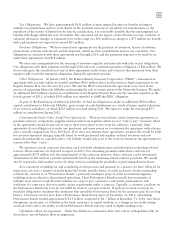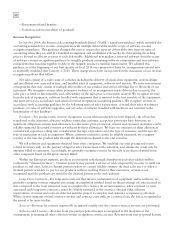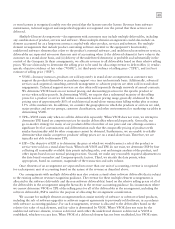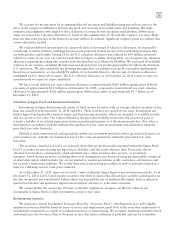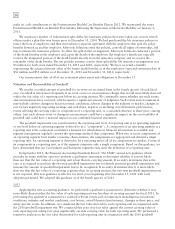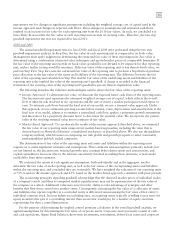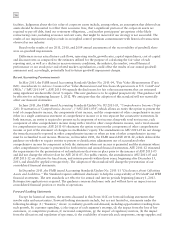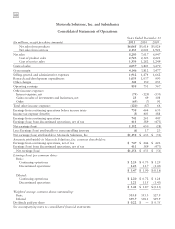Motorola 2011 Annual Report Download - page 58
Download and view the complete annual report
Please find page 58 of the 2011 Motorola annual report below. You can navigate through the pages in the report by either clicking on the pages listed below, or by using the keyword search tool below to find specific information within the annual report.
52
estimated based on estimates prepared at the time a restructuring plan is approved by management. Exit costs
consist of future minimum lease payments on vacated facilities and other contractual terminations. At each
reporting date, we evaluate our accruals for employee separation and exit costs to ensure the accruals are still
appropriate. In certain circumstances, accruals are no longer needed because of efficiencies in carrying out the plans
or because employees previously identified for separation resigned from the Company and did not receive severance
or were redeployed due to circumstances not foreseen when the original plans were initiated. In these cases, we
reverse accruals through the consolidated statements of operations where the original charges were recorded when it
is determined they are no longer needed.
Retirement Benefits
Our noncontributory pension plan (the “Regular Pension Plan”) covers U.S. employees who became eligible
after one year of service. The benefit formula is dependent upon employee earnings and years of service. Effective
January 1, 2005, newly-hired employees were not eligible to participate in the Regular Pension Plan. We also
provide defined benefit plans which cover non-U.S. employees in certain jurisdictions, principally the United
Kingdom, Germany, and Japan (the “Non-U.S. Plans”). Other pension plans are not material to us either
individually or in the aggregate.
We also have a noncontributory supplemental retirement benefit plan (the “Officers’ Plan”) for our elected
officers. The Officers’ Plan contains provisions for vesting and funding the participants’ expected retirement benefits
when the participants meet the minimum age and years of service requirements. Effective December 31, 1999, newly
elected officers were not eligible to participate in the Officers’ Plan. Effective June 30, 2005, salaries were frozen for
this plan.
We have an additional noncontributory supplemental retirement benefit plan, the Motorola Supplemental
Pension Plan (“MSPP”), which provides supplemental benefits to individuals by replacing the Regular Pension Plan
benefits that are lost by such individuals under the retirement formula due to application of the limitations imposed
by the Internal Revenue Code. However, elected officers who are covered under the Officers’ Plan or who
participated in the restricted stock buy-out are not eligible to participate in MSPP. Effective January 1, 2007, eligible
compensation was capped at the IRS limit plus $175,000 (the “Cap”) or, for those already in excess of the Cap as
of January 1, 2007, the eligible compensation used to compute such employee’s MSPP benefit for all future years
will be the greater of: (i) such employee’s eligible compensation as of January 1, 2007 (frozen at that amount), or
(ii) the relevant Cap for the given year. Additionally, effective January 1, 2009, the MSPP was frozen to new
participants unless such participation was due to a prior contractual entitlement.
In February 2007, we amended the Regular Pension Plan and the MSPP, modifying the definition of average
earnings. For years ended prior to December 31, 2007, benefits were calculated using the rolling average of the
highest annual earnings in any five years within the previous ten calendar year period. Beginning in January 2008,
the benefit calculation was based on the set of the five highest years of earnings within the ten calendar years prior
to December 31, 2007, averaged with earnings from each year after 2007. Also effective January 2008, we amended
the Regular Pension Plan, modifying the vesting period from five years to three years.
In December 2008, we amended the Regular Pension Plan, the Officers’ Plan and the MSPP (collectively, the
“2008 Amended Pension Plans”) such that, effective March 1, 2009: (i) no participant shall accrue any benefit or
additional benefit on or after March 1, 2009, and (ii) no compensation increases earned by a participant on or after
March 1, 2009 shall be used to compute any accrued benefit. In 2008, we recognized a $237 million curtailment
gain associated with this plan amendment.
Certain healthcare benefits are available to eligible domestic employees meeting certain age and service
requirements upon termination of employment (the “Postretirement Health Care Benefits Plan”). For eligible
employees hired prior to January 1, 2002, we offset a portion of the postretirement medical costs to the retired
participant. As of January 1, 2005, the Postretirement Health Care Benefits Plan was closed to new participants.
Accounting methodologies use an attribution approach that generally spreads individual events over the service
lives of the employees in the plan. Examples of “events” are plan amendments and changes in actuarial assumptions
such as discount rate, expected long-term rate of return on plan assets, and rate of compensation increases. The





